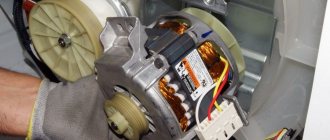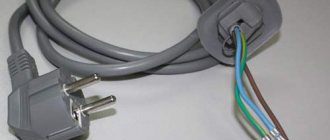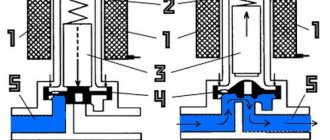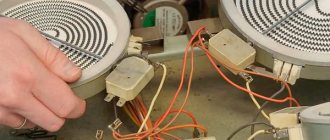The dishwasher does not heat the water. What needs to be done to find a breakdown, the repairman advises. Let's start from the beginning to understand the situation. Today, there are two main types of dishwashers based on the type of water used:
- With connection to cold water supply only.
- With connection to both cold and hot water supply.
Dishwashers with hot water connections are rare in Russia and the CIS. First, they are more expensive because they have an expensive mixing and water temperature control system. Secondly, they use more expensive hot water, which significantly affects utility bills. Such cars are not particularly popular in the Russian Federation.
Dishwashers with cold water supply independently heat the water to the temperature set by the program. Water heating is provided by a heating element in the machine itself. He is not visible, he is not in the tank. It is hidden in the machine's hydraulic system and is inaccessible to the user.
Causes of the problem
It happens that even at the first start the machine refuses to perform its functions. It is unlikely that the new machine could break; most likely it was due to an incorrect connection. If the device is not connected in the established order, the machine constantly draws and drains water.
When connecting a drain hose normally, a competent installer makes two smooth bends in the hose: one directly at the entrance to the device, the other at the junction with the siphon. Without this, water from the drain may flow back into the car. Therefore, if normal draining is impossible, there will be no water circulation in the dishwasher. Accordingly, the water temperature will differ from the parameter set by the program, that is, the water will be cold, and the consumer will blame the heating element for everything.
In this case, there is no need to do it yourself; it is better to contact an installation specialist.
But if the connection to the cold water system is done correctly, and the dishwasher still does not heat the water, you need to approach troubleshooting more thoughtfully, or rather, analyze the interaction of all the components of the device that affect the heating of the water. Of the fundamental reasons, three main ones can be distinguished:
- failure of the heating element;
- The thermostat does not regulate the temperature;
- control system is faulty.
Troubleshooting common problems
- Dishes do not dry.
The cause of the problem is the heating element. If it is in working order, check the high limit thermostat (the device that prevents the dishwasher from getting too hot). A faulty thermostat with a high limit can cause the heat to cut out before the dishes are completely dry.
The high limit thermostat is located on the bottom of the machine, just behind the access panel.
Advice!
First, check your rinse aid dispenser to make sure it is not empty and is dispensed correctly. Without rinse aid, dishes will not dry as quickly.
- Pungent and pungent odor.
Old, damp food is most likely the cause of any unpleasant odor coming from your dishwasher. Check carefully for any food and clean the dishwasher screen (located at the bottom).
If the machine has a chemical smell, the heating element may have melted one of the plastic plates that are built into the machine. Turn off the power and clean the mechanism with a damp cloth.
- Doesn't start.
Check your power supplies to make sure they haven't become a broken fuse. Make sure the outlet is working properly. Turn the machine's power on and off several times.
Checking and replacing the heating element
New dishwashers are required to be equipped with self-diagnosis systems. But in cases where problems arise with water heating, diagnostics often do not show error codes.
It is necessary to turn the machine over and, by removing the back wall, gain access directly to the heating element. The heating element is checked visually and using a tester and, if it is faulty, it is necessary to prepare for replacement. Due to the hardness of tap water, calcified scale deposits very heavily on the heating element, which sharply reduces the performance of this element. Therefore, heating element is considered a consumable material.
Electrolux dishwasher heating element
Replacing a heating element is a very expensive operation. The fact is that if a device such as a Bosch dishwasher does not heat water, then the heating element must be replaced as a whole module, which causes considerable financial costs.
What to do?
Let's consider the procedure for troubleshooting a particular dishwasher unit.
Replacing the heating element
The PMM heater is a flow-type element. Its design differs from heating elements used in electric boilers or other devices.
The procedure includes two stages:
- dismantling a burnt-out heater;
- installation of a new heating element.
Before you start replacing, you need to buy a new heating element and prepare the tools:
- slotted and cross-head screwdrivers (it will be inconvenient to use a screwdriver, it is better to prepare a regular tool);
- pliers;
- awl;
- multimeter to check the performance of the heating element.
Procedure:
Drain the water and turn off the machine, unplug the power plug. Open the door and remove all trays and baskets.- Remove the lower rocker arm, drain filter and metal mesh. The remaining water must be collected and removed with a rag or piece of foam rubber.
- Unscrew the fastenings of the circulation pump. Usually there are 5 of them.
- Turn the car upside down and remove the decorative panel, disconnect the bottom.
- Disconnect the block with wires and remove the pump.
- Disconnect the rubber clamp, all hoses and pipes from the heating element, and disconnect the power wires.
- Remove the burnt out heating element and install a new one.
- Connect the heater in reverse order and assemble the PMM.
After this, you need to start the car and check that the replacement was performed correctly.
The video will tell you about replacing the heating element in a dishwasher:
Control unit repair
The control unit is the “electronic brains” of the dishwasher. It is a board on which the parts are installed. Only a competent specialist with experience and knowledge can repair such a unit.
As a rule, only those units are repaired on which the fault is determined visually - a broken wire is visible, there are traces of water (condensation) ingress and other simple breakdowns.
If the fault is more complex, the entire assembly is replaced . Sometimes flashing the software helps. This is a complex procedure, available only to professionals.
If the machine is under warranty, independent actions with it automatically terminate the warranty agreement. If the warranty has already expired, it is still recommended to invite a technician from the service center.
Repairing the control unit (board) in a dishwasher - in the video:
Repairing the sensor
The temperature sensor cannot be repaired, it can only be replaced. To complete the work you will need:
- screwdrivers;
- pliers.
Procedure:
Find where the sensor is installed.
This is not easy as it looks different on all models. Usually it is installed at the very bottom (or at the top if the car is turned over), under the cover.- Disconnect fasteners and wires from the burnt out sensor.
- Install and connect a new element.
- Assemble the car.
The last step will be a trial run and evaluation of the effectiveness of the procedure performed.
Diagnostics and repair of the thermostat and control unit
The temperature sensor or thermostat is one of the weak points of most dishwashers. It is necessary to clearly understand that it is he who has failed, so the diagnostic algorithm will be as follows:
- We disconnect the device from the supply voltage and water supply;
- remove all dish baskets;
- dismantle the lower sprinkler and remove the garbage filter;
- install the device upside down and remove the side fastenings;
- carefully disconnect the drain pipe and lift the bottom of the dishwasher
- Having gained access to the thermostat, disconnect it from the supply wires;
- We clean the contacts of the temperature sensor and check it with a tester.
- if the thermostat is faulty, replace it and reassemble the dishwasher, having first checked the wiring leading to the thermostat.
Gorenje dishwasher temperature sensor
It happens that the temperature sensor is in order, and all other elements are checked, but the water is still cold. In this state of affairs, most likely the control unit, or one of its constituent elements, has failed. In this case, the dishwasher “computer” does not work, which compares all the data from other components of the device and gives a command to heat the water. If a malfunction occurs, the command to the heating element to heat the water may not go through.
The unit is very expensive, so only an experienced specialist should repair or replace it.
In addition to the main reasons for refusing to heat water, there are additional ones. It seems that they have nothing to do with heating the water, but this is not the case. Let us carefully analyze the following reasons:
- clogged dishwasher filter;
- the washing mode is incorrectly selected;
- failure of the pressure sensor.
What to do if the dishwasher does not heat the water?
An important issue is the way to solve the problem. Undoubtedly, it is individual for each case. Somewhere you can get by with cleaning. And somewhere you will need to replace expensive elements. There is no universal remedy.
You can try washing the filters yourself. Reset the program. And test the dishwasher on different washing modes. There may have been a short-term glitch. And after a restart everything will work.
If the problem does not go away. Unfortunately, this cannot be done without the help of a qualified specialist. For some dishwashers, diagnosing the problem is quite easy. For others it's the opposite. The abundance of elements in the heating circuit. Can cause difficulties, especially if the problem is not permanent...
Clearing a clogged filter
The garbage filter is rightfully considered one of the main components of a dishwasher. Its functional task is to prevent food debris and dirt waste from penetrating the main working elements. Dirt gradually collecting in the filter cavity prevents normal water circulation in the device, so the heating element turns off and the dishwasher does not heat the water. To normalize the operation of the machine, it is necessary to clean the filter.
The bottom line is that when you turn on the washing program, water should communicate well between the storage tank and special containers. At this time, the heating element maintains a constant temperature necessary for high-quality washing. If the filter is partially or completely clogged with debris, circulation becomes far from normal. Water accumulates in the tank, and the system will be forced to replenish reserves using cold tap water. Ten won't be able to heat it up.
It is important for the consumer to remember that in order to avoid this malfunction, it is necessary to thoroughly clean the dishes before placing them in the dishwasher.
It would also be a good idea to look into the storage tank while working. If it fills with water, it is necessary to promptly clean the filter. As a result, normal circulation will be restored and the problem with water heating will disappear, unless the heating element fails due to a blockage or the thermistor does not burn out synchronously.
Possible reasons when the water does not heat up in the dishwasher
The main reasons why the water in the dishwasher does not heat up are:
- heating element malfunction;
- failure of the temperature sensor;
- control board is faulty.
In addition, reasons that at first glance are not related to water heating, but in fact indirectly affect it, may be:
- incorrect connection of the dishwasher;
- clogged garbage filter;
- incorrectly selected dishwashing mode;
- failure of the pressure sensor. By the way, before changing it, it is worth cleaning its contacts and checking the serviceability of the wiring going to it.
The question arises - what does the filter have to do with it? It's simple - if the filter is clogged, there is no water circulation between the tank and the tanks, the system replenishes water, but it does not return from the tank to the tanks. Ten doesn’t have time to heat it up. To identify this malfunction, just look into the tank during the washing process. During normal operation of the filter, water does not remain in it. If there is a problem, the filter needs to be cleaned.
If the connection to the sewer is incorrect, there will be no normal circulation of water in the dishwasher, and its temperature will not correspond to the norm, if it heats up at all. In this case, you need to connect the machine to the sewer system as shown in the instructions.
Selecting dishwasher modes
Very often, the water in the dishwasher does not heat up due to an incorrectly set mode. If the electromechanical regulator is fixed at 40 degrees, and the toggle switch is set at 90, then the device heats cold water to no more than 40 degrees.
The most advanced models always have a mode called “delicate wash”. When operating in this mode, the water also does not heat above 40 degrees. To avoid such troubles, you must carefully study the technical description of the device.
The dishwasher has stopped heating the water and will not dissolve the tablet.
This feature may be due to a lack of heating or other problems. If during washing. Only cold water is used. The tablet may only partially dissolve. In this case, it usually spreads down the door. There may also be a small part left at the bottom, under the basket.
Without hot water, the washing result will be very far from the standard. If you notice that the dishes are poorly washed. Drops remain on it and after the completion of the washing cycle (If you open the door immediately) there is no characteristic steam. In this case, most likely your dishwasher has stopped heating the water.
Features of the pressure sensor
The main purpose of this unit is to control the circulation of water in the machine. If the pressure sensor stops functioning, then continuous circulation of water occurs in the system, which ultimately leads to its automatic drainage. Naturally, the heating element with constant circulation simply does not have time to properly heat the water, and washing is done with cold water. The problem can be resolved by replacing the sensor, although you can try to clean its contacts and check the supply wiring.
As a result, it should be noted that if the water heating has disappeared, there is no need to be alarmed, but by consistently eliminating failure options, identify and eliminate the true cause of the failure.
Checking water heating in the dishwasher
If the heating system is not working, the energy consumption of the dishwasher is significantly reduced. Heating element is the main consumer of electricity. If it does not work, consumption is significantly reduced. This can be checked either using a special wattmeter or simply using an electricity meter.
If the heating functions, but not correctly (the filter is clogged, the pressure sensor is broken, the device is incorrectly connected to the drainage system), the PMM will consume electricity within normal limits. However, the washing result will be unsatisfactory.
The water doesn't heat up - what's the problem?
Often there is a problem of cold water in the tank. If the dishwasher does not heat the water, as a rule, this indicates a breakdown of the heating element. But often the heating element is working properly, but the reason lies elsewhere. Sometimes, the water remains cold due to the wrong choice of washing program, or a clogged drain filter. The cost of fixing the problem depends on correct diagnosis.
So, the main reasons for the lack of water heating are:
- Breakage of the heating element.
- Thermostat failure.
- Damage to the control unit (popularly called “brains”).
Breakage of heating element
If the heating element breaks down, it should be replaced with a new one. Heating elements cannot be repaired and if they burn, they cannot be restored. Before rejecting the heating element, you should check its contacts. It happens that they oxidize due to overheating and become covered with plaque.
The contacts of the wires feeding the heating element are also covered with plaque. Because of this, contact may be lost and the heating element may not work. In this case, it is recommended to replace the contacts on the wires, re-crimping them with new ones, and clean the heating element contacts until they shine.
Some craftsmen recommend using copper paste when connecting the heating element. It is used to carefully lubricate the contacts of the heating element so that the paste does not get on anything else. Lubricate lightly to avoid even the slightest contact with other parts of the heating element or dishwasher. Then put on the terminals
wires Copper paste will adhere to the contacts and protect them from plaque formation and loss of contact. Also, you should check the wiring itself that powers the heating element.
IMPORTANT! Copper paste is a conductive material. When working with it, you should be careful!
Heating element for Bosch dishwasher.
Thermostat failure
Why doesn't the dishwasher heat the water? Thermostat failure is the second possible reason for the lack of water heating. It is diagnosed only after the heating element has been tested and its performance has been confirmed. You can check the thermostat only by removing it and measuring its resistance at different temperatures of the thermostat housing.
Each thermostat has its own values. You need to search for them on the Internet for each thermostat model separately.
Before taking measurements, the sensor contacts should be cleaned until shiny. If the sensor is faulty, it is replaced with a new one. Before installing a new thermostat, you should check its wiring. If the wire contacts are oxidized, they need to be replaced.
Dishwasher thermostat.
Control unit failure
If the thermostat and heating element are in order, you need to check the control unit itself. It is impossible to diagnose this part at home. To do this you will need a diagnostic scanner. But you can visually inspect it. Perhaps some contacts are burnt, and you can replace them yourself. If everything is visually in good order, but the control unit does not work, then only an experienced electronics engineer can repair it.
How to replace the heating element
If the problem is in the heater, buy the part and change the heating element. Before doing this, calculate how profitable the repair will be: if the PMM is old and they won’t give you more than 10,000 rubles for it, then it’s not profitable to buy a spare part. But the decision is yours to make.
How to replace the heating element:
- Open the hopper and remove the baskets.
- Turn off the power to the machine, remove the hoses.
- Remove the spray arm.
- Unscrew the filter.
- Remove the stainless mesh.
- Unscrew the fasteners that hold the pipe and instantaneous water heater.
- Turn the appliance upside down.
- Turn the pump half a turn to the right and pull to remove the part.
- Remove the sensor and set the pump aside.
- The flow heater is held on a rubber mount. Find the fastener and disconnect.
- Then remove the sensor plugs, pipes and remove the burnt heating element.
- Install the new part, reassemble the machine, proceeding in the reverse order.
Why does the water in the dishwasher remain cold?
Why doesn't the dishwasher heat the water? To answer this question, it is necessary to approach the solution of the problem systematically, namely, to consider the interconnections of all units and sensors of the dishwasher and decide what can (at least indirectly) negatively affect the operation of the heating element? There are three main reasons why the water in the dishwasher remains cold:
- the heating element itself is faulty;
- The thermostat is faulty;
- control unit element is faulty.
In addition to the main reasons why the water in the car does not heat up, there are additional ones. At first glance, it seems that these breakdowns cannot have any effect on the thermoelements at all, but this is actually not the case. Let's look at additional reasons why the water in the dishwasher tank is not heating up.
- The dishwasher is not connected according to the instructions.
- There is a severe blockage in the garbage filter.
- User error when selecting a washing mode.
- The pressure sensor is faulty.











